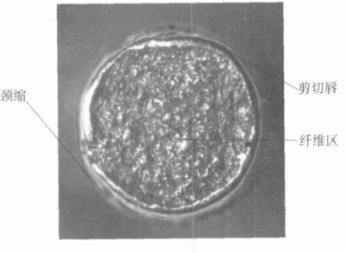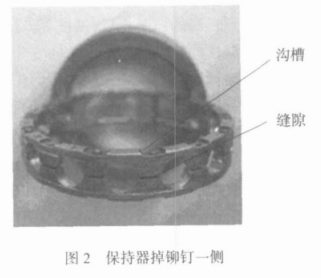2022 October the Fifth Week WSW Technical Knowledge: Analyzing deep groove ball bearing cage rivet for fracture reason
Abstract: According to the shape and features of fracture face of rivet and inner and outer rings of bearing after failure, the mechanism resulting in bearing failure was analyzed.
Key words: rivet; fracture face; bearing failure
1 Introduction
The bearing is usually composed of four main parts, namely inner sleeve, outer sleeve, rolling element and cage. The role of the cage is to keep the rolling element in the correct position when the bearing is running. Once the bearing cage is damaged, it will usually cause the overall failure of the bearing. Sometimes, the broken cage will crush the rolling element, or even lock the bearing to cause an accident. It can be seen that the role of cage in the bearing cannot be ignored. The rivet used to connect the cage is the guarantee for the reliable operation of the cage. If it breaks, the cage will be damaged.

After a set of deep groove ball bearing was delivered to the customer for 300h, the cage rivet broke. The customer returned the failed bearing to the factory to analyze the cause of the cage rivet fracture.
2 Inspection and analysis
As the failure part of the bearing is rivet, the method of breaking rivet and removing cage to separate the inner and outer sleeve and rolling body is not adopted in the bearing sleeve removal analysis, but the method of cutting the bearing sleeve from both sides by wire cutting and sleeve removal is adopted. With this method, the original state of the failed parts is maintained, which lays a foundation for accurately finding the cause of failure.
After disassembling the bearing, take down the broken rivet and observe it under the microscope. The necking and complete shear lip can be clearly seen from the enlarged fracture surfaces of the two broken rivets. The fracture surfaces are fibrous and gray under the microscope, as shown in Figure 1. Rivet material is ML15. ML15 is a typical low-carbon steel with a carbon content of about 0.15%. Generally speaking, the axial tensile fracture surface of low-carbon steel sample is composed of three parts, namely, shear lip, radiation area and fiber area, and there is also obvious necking near the fracture surface. Necking is a phenomenon that the deformation of metal materials with good plasticity concentrates in local areas during the tensile process. It is the result of the joint action of strain hardening and section reduction. Before the axial tensile stress of the low-carbon steel sample reaches the yield point, the plastic deformation is uniform. After the axial tensile stress exceeds the yield point, because the strain hardening cannot keep up with the development of plastic deformation, the deformation is concentrated in local areas and necking occurs. The formation of the fiber zone is due to the necking of the local area of the sample when the stress reaches the yield point of the material in the axial tensile process. At the same time, the stress state of the sample also changes from unidirectional to three-way, and the central axial stress is the largest. Under the action of central three-way tensile stress, plastic deformation is difficult to carry out, which causes the inclusion in the central part of the sample or the particle of the second phase itself to break, or the particle of the inclusion separates from the interface of the matrix to form micropores. Microcracks are formed when micropores grow and polymerize. The microcracks continue to expand and connect with each other to form serrated fiber areas, and the gray color is caused by the weak light reflection ability of the fiber fracture. At the last stage of tensile fracture of the specimen, the edge of the specimen is sheared and fractured to form a cup or cone shaped shear lip. The surface of the shear lip is smooth and approximately 45 ° to the tensile axis. It can be seen from the observation that the fracture morphology of the broken rivet conforms to most of the characteristics of the tensile fracture of the low-carbon steel sample, with fiber zone, shear lip and obvious necking. No obvious radiation zone was observed on the fracture surface because the axial force increased instantaneously and the fracture occurred when the plastic deformation was completed in the future. The bearing is an angular contact ball bearing. Although it must bear a certain load in the axial single direction, the cage and rivet should not bear a large load when stressed, so as to cause the cage rivet to break. In order to find out the cause of cage rivet tensile fracture, the inner and outer sleeves and cage were observed and analyzed.
After determining that the rivet is plastic fracture caused by tension, it can be concluded that the cage must be subjected to an axial force. The following describes how this axial force is generated and applied.

Figure 1
By observing the cage and the inner and outer sleeves of the bearing, it is found that the joint of the two half cages has produced a large gap, and the corresponding positions of the outer diameter, inner diameter and ring groove edge bulges are cut out of the groove, as shown in Figure 2. There are obviously evenly distributed indentations on both sides of the outer jacket trench, forming 26 waves, with peaks and valleys on both sides facing each other, and the trench edge is convex, as shown in Figure 3. The inner channel is peeled off to varying degrees, the deformation of the channel is large and deep, and the edge of the channel is convex, as shown in Figure 4. The surface of the steel ball is peeled off to varying degrees.

Figure 2

Figure 3

Figure 4
Comply with the GCr15 steel composition specified in GB/T18254-2002 national standard. The structure hardness of each part also meets the requirements of JB1255 quality standard for bearing steel heat treatment. It can be seen that the failure of the bearing may be related to the use of the customer.
From the characteristics that the two half cages are stretched out and the ridge at the edge of the channel is wavy, it can be inferred that the fault is caused by the axial vibration impact force borne by the working shaft, which causes the axial impact force generated by the steel ball that should rotate in a circle along the channel to act on both sides of the channel, resulting in plastic deformation at the edges of both sides of the channel, and the ridge at the edge of the channel is wavy (26 waves are evenly distributed, and the peaks and valleys on both sides are opposite, indicating regular vibration); This axial impact force acts on both sides of the cage pocket at the same time, causing the two half cages to separate, and the rivet is pulled off by the axial stretching force. The necking and complete shear lip can be clearly seen on the fracture surface of rivet, and the tensile fracture feature is obvious.
Because the abnormal axial vibration impact force exceeds the bearing load limit, the bearing is prematurely damaged.
3 Conclusion
(1) The materials of bearing inner and outer rings and steel balls shall conform to the GCr15 steel composition specified in GB/T18254-2002 national standard, and the heat treatment quality shall conform to JB1255.
(2) The abnormal axial vibration impact force in the bearing operation is the fundamental cause of bearing failure and rivet fracture.
More about WSW Deep Groove Ball Bearing:
Deep groove ball bearings are the most widely used bearing type and are particularly versatile. In structure, each ring of deep groove ball bearing has a continuous groove raceway with a cross section of about one third of the circumference of the ball. It can bear certain axial load and radial load. When the radial clearance of the bearing increases, it has the property of angular contact ball bearing and can bear the alternating axial load in two directions. Low friction and high speed. Simple structure, low manufacturing cost and easy to achieve high manufacturing accuracy. Generally, stamping wave cage is adopted. For bearings with inner diameter greater than 200mm or high-speed operation, turning solid cage is adopted.


